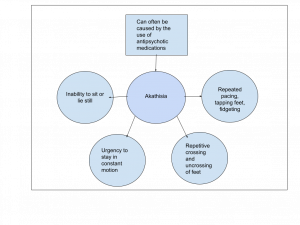Introduction
This is an assignment that introduces the three types of definitions (parenthetical, sentence, expanded). The definitions used are differentiated by the audience, purpose and situation. Each team member is assigned to select a specific term that is relevant to their profession to educate an audience that does not have the technical knowledge of that term. The reading situation for this assignment is to explain the definition of akathisia as a pharmacist to their patient who does not have prior knowledge about the condition.
Parenthetical
Akathisia (feeling of restlessness) is one of the most common side effects of certain psychiatric medications (Lohr et al., 2015).
Sentence
Akathisia is a movement disorder characterized by a persistent feeling of restlessness and desire to move that can be caused by certain psychiatric medications (Kumar., 2009).
Expanded Definition
Akathisia is a movement disorder that is defined as the inability to remain still. Akathisia is characterized by an intense feeling of restlessness or uneasiness that prevents the individual from sitting or lying still (Lohr et al., 2015). The movements are often described as being repetitive in nature such as pacing and fidgeting (Patel et al., 2022).
Etymology:
The term “akathisia” is derived from the Czech word “Akathisie” created by Ladjslav Hascovec, a Czechoslovakian neuropsychiatrist who originally based it on the Greek phrase of “not to be made to sit down.” (Lohr et al., 2015).
History:
In 1923, Akathisa was first described as a psychiatric condition, but was later categorized as a movement disorder when it was discovered to be caused by antipsychotic medications in the 1950s, which led to it becoming grouped together with other related movement problems (Lohr et al., 2015).
Comparison and Contrast:
Due to excessive movement observed in patients with agitation or anxiety, akathisia can often be confused for those conditions. Akathisia can be differentiated based on a preference for lower extremity movement, urgency to move, and relief as a result of movement (Lohr et al., 2015).
Visual:

Figure 1. Symptoms and common cause of Akathisia
Akathisia, as shown in the figure, is often a side effect caused by psychiatric medications such as antipsychotics used to help patients manage specific behavioural or mood disorders (Patel et al., 2022).
References
Lohr, J., Eidt, C., Abdulrazzaq Alfaraj, A., & Soliman, M. (2015). The clinical challenges of akathisia. CNS Spectrums, 20(S1), 1-16. doi:10.1017/S1092852915000838
Kumar, R. & Sachdev, P. S. (2009). Akathisia and second-generation antipsychotic drugs. Current Opinion in Psychiatry, 22 (3), 293-299. doi: 10.1097/YCO.0b013e32832a16da.
Patel, J., & Marwaha, R. (2022, July 25). Akathisia – StatPearls – NCBI Bookshelf. StatPearls [Internet]. Retrieved February 7, 2023, from https://www.ncbi.nlm.nih.gov/books/NBK519543/
Leave a Reply